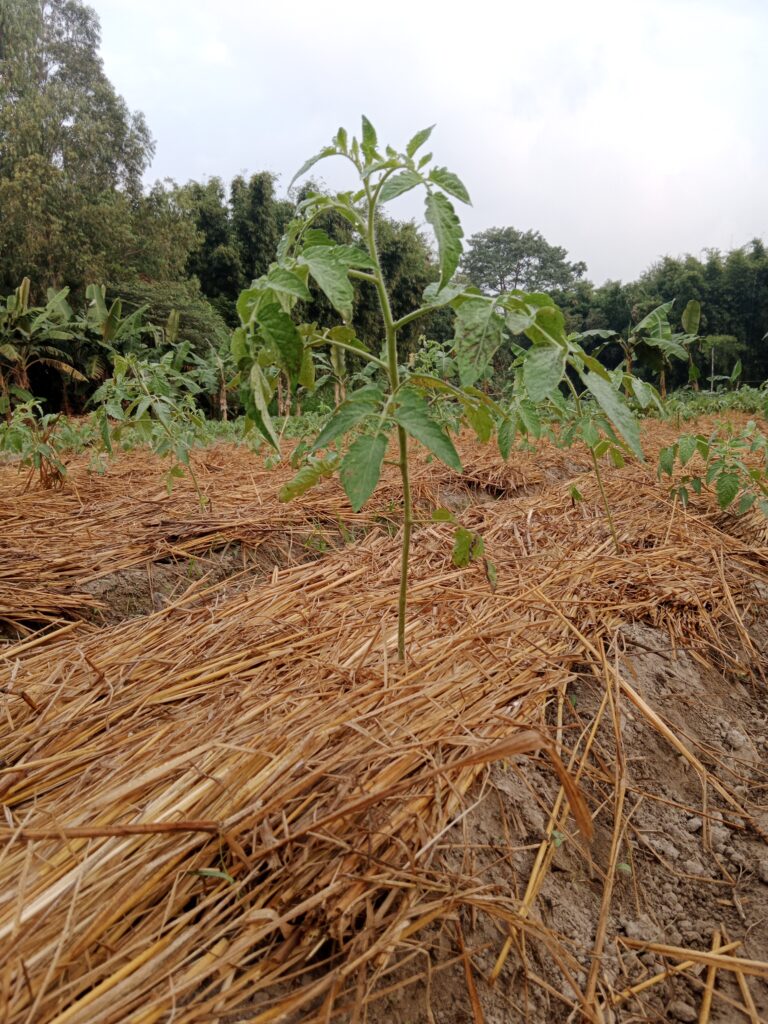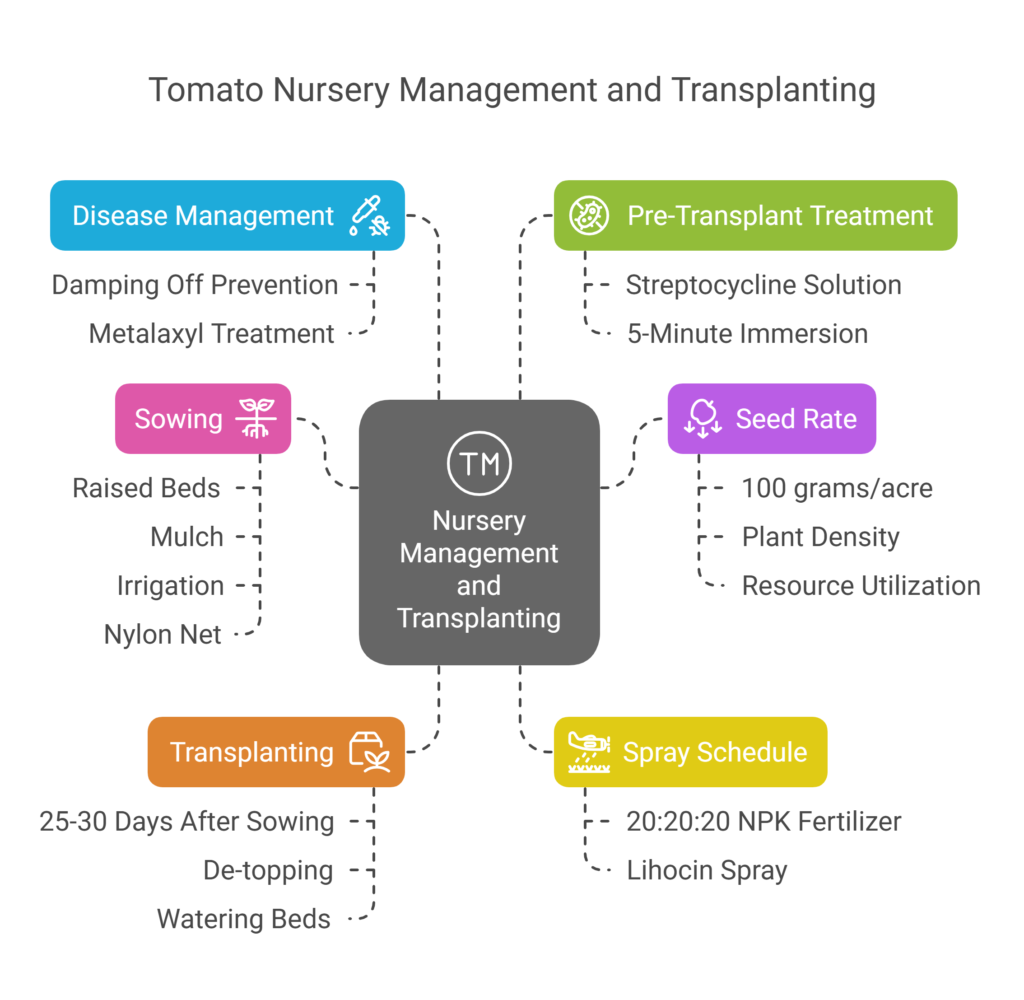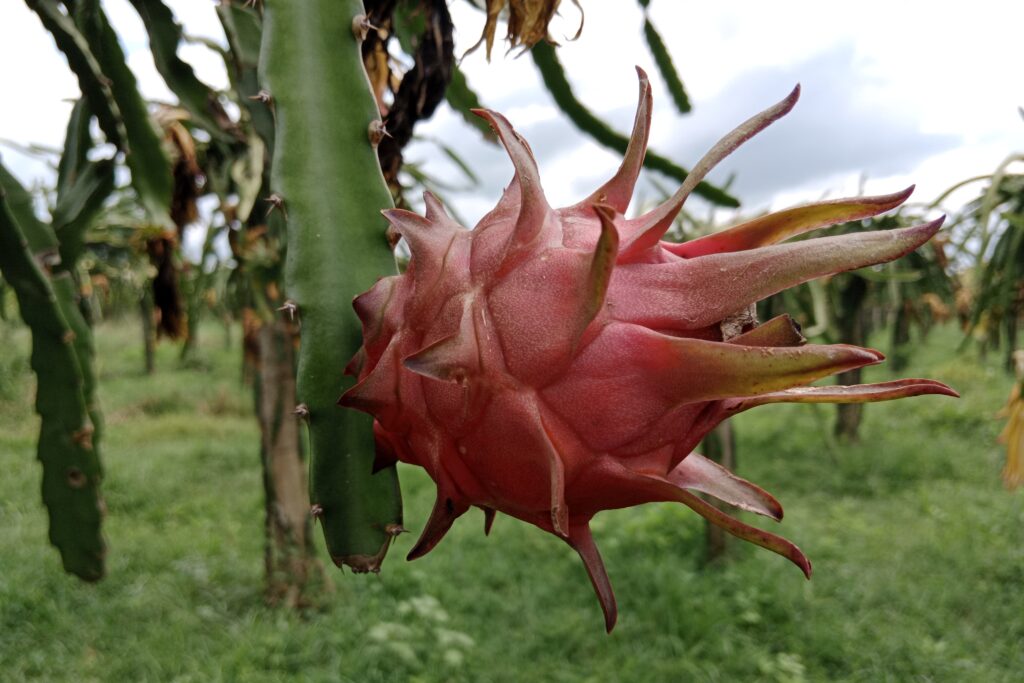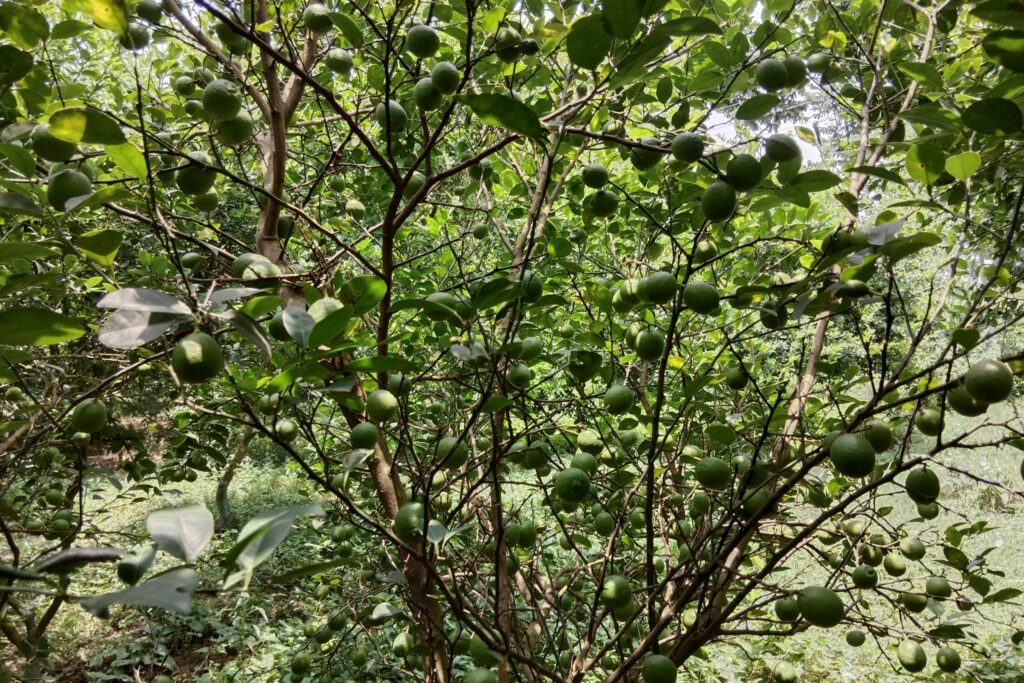Tomato Farming
Tomato farming profit per acre is a pivotal metric for farmers evaluating the economic viability of this high-value crop. By subtracting the total investment cost (NRs. 43,000) from the gross income (NRs. 225,000), the net profit stands at NRs. 182,000 per acre, reflecting a robust profit margin of 80.89% [(182,000 ÷ 225,000) × 100].

This impressive margin underscores tomato farming’s potential for lucrative returns, contingent on achieving stable yields (15,000 kg/acre) and favorable market prices (NRs. 15/kg). Key cost drivers—land preparation, fertilizers, and labor—demand strategic allocation, while proactive pest control, efficient irrigation, and disease management are critical to sustaining yields. For farmers, optimizing these variables can maximize tomato farming profit per acre, transforming it into a resilient and rewarding agribusiness venture amidst fluctuating market dynamics and climatic challenges.
Land Preparation
Begin with deep plowing (20-25 cm) using a tractor or tiller to loosen soil, followed by 2-3 harrowings to break clouds. Form raised beds or ridges (15-20 cm height, spaced 60-90 cm apart) to enhance drainage. Enrich soil by incorporating 10-15 tons/acre of well-decomposed compost or farmyard manure and adjust pH to 6.0-6.8 using lime (for acidic soil) or sulfur (for alkaline soil) based on soil tests.
Level the field evenly to prevent waterlogging. To eliminate soil-borne pathogens, pests, and harmful organisms, conduct soil solarization by covering the field with transparent plastic mulch for one month before sowing; this traps solar radiation, raising soil temperatures to sterilize the soil effectively.
Soil Type
Optimal soil for tomato cultivation is well-drained sandy loam or loam rich in organic matter, with a pH range of 6.0–6.8. Heavy clay or waterlogged soils should be avoided to minimize root diseases and ensure healthy plant growth through proper aeration and nutrient availability.
Climatic Requirements
Since frost can seriously harm or even kill plants, tomatoes do best in warm, frost-free climates with ideal daytime temperatures of 20 to 30°C and at least 12°C. For strong photosynthesis and fruit growth, they need 6–8 hours of direct sunlight every day; however, extended exposure to temperatures above 35°C may make pollination more difficult.
In order to maintain constant soil moisture, particularly during flowering and fruiting, moderate yearly rainfall (600–900 mm) is desirable, although additional irrigation is essential during dry spells. To reduce fungal infections like blight or powdery mildew, which flourish in damp, stagnant environments, low to moderate humidity levels are ideal. High yields and healthy development are guaranteed by appropriate temperature control, balanced watering, and airflow.
Major Cultivars
a). Determinate
Determinate tomato varieties, such as Roma and Celebrity, are classified as bush-type plants due to their compact, controlled growth habit, making them ideal for mechanical harvesting and processing purposes. These plants grow to a predetermined height (typically 3–4 feet), set fruit in a concentrated period, and cease vegetative growth once fruit clusters mature, ensuring uniform ripening and synchronized yields—key traits for commercial processing (e.g., sauces, pastes, or canned products).
Their sturdy, bushy structure minimizes the need for staking, simplifies field management, and suits high-density planting. Roma tomatoes, for instance, are prized for their dense, meaty flesh and low moisture content, while Celebrity offers disease resistance and consistent fruit size. Determinate types thrive in environments requiring predictable harvest windows and bulk processing efficiency.
b). Indeterminate
Indeterminate tomato varieties, such as Beefsteak and Cherry, are characterized by their vining growth habit, continuously elongating and producing fruit throughout the growing season until halted by frost. These varieties are preferred for fresh markets due to their extended harvest window, which ensures a steady supply of high-quality, flavorful fruits.
Beefsteak tomatoes, known for their large, juicy slices, and Cherry tomatoes, prized for their sweet, bite-sized appeal, thrive on vertical supports like stakes, trellises, or cages to manage sprawling vines and improve air circulation, reducing disease risks. Their vigorous growth demands regular pruning and maintenance but rewards with consistent yields of tender, nutrient-rich fruits ideal for salads, sandwiches, and direct consumption. Indeterminate types prioritize taste and texture over uniformity, making them less suited for mechanical processing but highly valuable for premium fresh produce markets.
c). Hybrids
Hybrid tomato varieties, such as Tengeru 97 (widely adopted in Africa) and Hybrid 61 (popular in Asia), are scientifically bred to combine disease resistance with high yield and adaptability to regional growing conditions. Tengeru 97, developed for African climates, exhibits robust resistance to prevalent pathogens like bacterial wilt, Fusarium, and tomato yellow leaf curl virus (TYLCV), reducing reliance on chemical pesticides and ensuring stable production in smallholder farms.
Similarly, Hybrid 61, tailored for Asian agroecosystems, offers tolerance to fungal blights, nematodes, and abiotic stresses like erratic rainfall, enhancing resilience in high-humidity or variable environments. These hybrids are engineered through controlled cross-pollination to merge traits like vigor, uniform fruit size, and extended shelf life, addressing challenges such as post-harvest losses and market demands.
While they often require purchasing new seeds annually, their ability to mitigate crop losses and boost farm profitability makes them pivotal for food security and sustainable agriculture in regions prone to pest outbreaks and climatic instability.
Nursery Management and Transplanting

a). Sowing
Plant tomato seeds on raised beds (80-90cm wide), cover with mulch, irrigate daily using a Rose-Can in the morning, and shield the nursery with a fine nylon net to prevent viral infections.
b). Seed rate
Use 100 grams of seeds per acre to raise seedlings for transplantation, ensuring adequate plant density and efficient resource utilization while avoiding overcrowding or seed wastage for healthy crop establishment.
c). Spray Schedule
Apply a 20:20:20 NPK fertilizer with micronutrients (2.5-3g/L water) 10-15 days after transplanting for balanced nutrition, followed by a Lihocin spray (1ml/L water) 20 days post-sowing to strengthen seedlings and improve transplant resilience.
d). Disease Management
Prevent Damping Off by avoiding seedling overcrowding and maintaining moist soil; if wilting appears, apply 2-3 soil drenches of Metalaxyl (2.5g/L water) until plants recover for transplantation.
e). Transplanting
Seedlings are ready for transplantation 25-30 days after sowing (with 3-4 leaves); if older than 30 days, de-top before planting. Water beds 24 hours prior to ease uprooting and ensure seedlings remain turgid during the process.
f). Pre-Transplant Treatment
To safeguard against bacterial wilt, immerse seedlings in a 100ppm Streptocycline solution for 5 minutes prior to transplanting, ensuring thorough protection during establishment.
Planting
a). Planting Season
| Climate/Region | Sowing Time | Transplanting Time | Notes | |
| Temperate | Spring (post-frost) or Summer | – | Avoid frost periods. | |
| Tropical | Late November (spring crop) / July–August (autumn crop) | Mid-January (spring) / August–September (autumn) | Spring crop sown in late Nov, transplanted in Jan; autumn crop sown in July–Aug. | |
| Hilly Areas | March–April | April–May |
b). Spacing
Maintain rows 75–90 cm apart and space plants 40–60 cm within rows to ensure proper growth, airflow, and resource access while minimizing disease risks.
c). Pit Preparation
Dig holes 15–20 cm deep and mix the excavated soil with 100g compost, 10g phosphorus, and muriate of potash (MOP) per pit to boost potassium availability and nutrient-rich soil for healthy root development.
d). Planting Method
Transplant 4–6-week-old seedlings (with 2–4 true leaves) during morning or evening hours to minimize heat stress and ensure optimal establishment.
e). Number of Plants/Acre
Depending on row (60–90 cm) and plant (30–60 cm) spacing, density ranges from 7,495 to 13,490 plants per acre, allowing flexibility for growth habits, management practices, and yield optimization.
Irrigation
Opt for drip irrigation (water-efficient) or furrow systems, avoiding overhead watering to minimize disease risks. During the seedling stage, maintain light, frequent irrigation to support establishment, then increase to 1–2 inches weekly during flowering and fruiting. Post-fruit set, reduce watering to prevent cracking, adjusting schedules based on soil moisture and growth phases to maximize yield and fruit quality.
Tomatoes are highly sensitive to water stress, especially post-transplanting and during flowering/fruit development, requiring consistent moisture without waterlogging. Ensure flooded fields are drained within 1–3 days to avoid root damage. Furrow irrigation reduces fungal spread (e.g., Early Blight), while drip systems enhance water efficiency. Overhead methods should be avoided due to disease promotion. Balance irrigation to meet crop needs while prioritizing drainage and method choice for healthy, high-yielding plants.
Fertilizer and Manure
| Application Type | Timing | Quantity/Method | Purpose/Notes |
| Basal Application | Pre-planting | 20–30 tons compost + 200 kg NPK (10-10-10)/acre | Enriches soil with organic matter and balanced nutrients. |
| Top-Dressing | 3–4 weeks post-transplant | 50 kg urea/acre | Boosts vegetative growth. |
| Top-Dressing | Flowering stage | 50 kg potassium sulfate/acre | Enhances fruit development and quality. |
| Foliar Spray | As needed | Calcium spray | Prevents blossom end rot. |
Weed Control
Effective weed management involves mulching with organic materials (e.g., straw) or plastic sheets to suppress weed growth and retain soil moisture, combined with 2–3 manual weeding sessions during early crop stages to eliminate competition. Pre-emergent herbicides like Metribuzin can be applied cautiously post-transplanting, ensuring proper dilution and adherence to guidelines to avoid phytotoxicity. Integrate these methods to minimize weed interference while safeguarding crop health and yield.
Pest and Disease Management

Common Pests
a). Aphids
Aphids, small sap-sucking pests, weaken plants by draining nutrients and excreting sticky honeydew that promotes sooty mold growth. They also transmit viral diseases (e.g., CMV, TYLCV). Manage infestations with insecticidal soaps, neem oil, or biological controls (ladybugs, lacewings). Monitor regularly and apply targeted sprays early to prevent outbreaks.
For chemical control, spray imidacloprid 17.8% SL @ 1ml / litre water.
b). Whiteflies
Whiteflies, both nymphs and adults, damage plants by sucking cell sap, weakening growth, and excreting honeydew that promotes black sooty mold. They also transmit viral leaf curl diseases. Prevent infestations by covering nursery beds with 400-mesh nylon nets or thin white cloth post-sowing and deploying yellow sticky traps coated with grease to monitor and trap adults. Remove and destroy severely infested plants to curb spread. For severe outbreaks, apply chemical sprays such as Acetamiprid 20SP (80g/200L water), Triazophos (250ml/200L), or Profenophos (200ml/200L), repeating treatment after 15 days to disrupt the pest lifecycle.
c). Hornworms
Tomato hornworms, large green caterpillars with voracious appetites, rapidly defoliate plants, stripping leaves and damaging fruit. For small-scale infestations, handpicking (ideally at dawn/dusk when active) and destroying larvae is an effective organic method. For larger outbreaks, apply Bacillus thuringiensis (Bt), a microbial insecticide that disrupts the caterpillars’ digestive systems upon ingestion, causing fatal toxicity within days.
Bt is safe for beneficial insects, humans, and pollinators when used as directed. Combine these methods with habitat management—encouraging natural predators like parasitic wasps or birds—and regular scouting to detect eggs (small, spherical, light-green) on leaf undersides. Avoid broad-spectrum pesticides to preserve ecological balance and sustain long-term garden health.
d). Leaf miner
Leaf miner larvae tunnel into tomato leaves, creating serpentine mines that disrupt photosynthesis and impair fruit development. For early-stage infestations, apply Neem Seed Kernel Extract (5% solution, 50g/L water) as an organic deterrent. Severe cases require chemical intervention: spray Dimethoate 30EC (250ml/200L water), Spinosad (80ml/200L water), or Triazophos (200ml/200L water) to target larvae and halt leaf damage. Timely application at the first signs of mining is critical to preserve plant vigor and yield.
e). Mites
Mites, a globally distributed pest causing up to 80% yield loss, infest crops like tomato, potato, chilli, and citrus by feeding on the lower leaf surfaces, leading to cupped leaves, defoliation, bud shedding, and leaf drying. For severe infestations of yellow mites or thrips, apply Chlorfenapyr (15ml/10L water), Abamectin (15ml/10L), or Fenazaquin (100ml/100L). Spiromesifen 22.9SC (Oberon@200ml/acre in 180L water) offers effective control. Timely sprays during early infestation stages are critical to mitigate damage and preserve crop health.
Common Diseases
a). Early Blight
Early blight, a major fungal disease, initially appears as small brown spots on leaves, later spreading to stems and fruits, evolving into irregular dark-brown lesions with concentric rings. Severe infections cause defoliation and yield loss. For active infestations, spray Mancozeb (400g/200L water) or Tebuconazole (200ml/200L), repeating after 10–15 days.
In cloudy, humid conditions (prone to blight outbreaks), apply Chlorothalonil (250g/100L) preventively. During sudden rainfall, use copper-based fungicides (300g/L) combined with Streptocycline (6g/200L) to suppress bacterial co-infections and manage disease progression. Integrate timely sprays with crop rotation and residue removal for long-term control.
b). Damping Off and Wilt
Damping off, a soil-borne fungal disease, thrives in moist, poorly drained soils, causing water-soaked stems, seedling collapse, and pre-emergence death. To prevent root rot, drench nursery soil with 1% urea (100g/10L water) and Copper oxychloride (250g/200L). For wilt control, apply soil drenches of Copper oxychloride (250g/200L) or Carbendazim (400g/200L).
High humidity and temperature from irrigation exacerbate fungal growth; counter this by applying Trichoderma (2kg/acre mixed with cow dung) near roots to boost beneficial microbes. One month post-treatment, drench soil with Carbendazim (1g/L) or Bordeaux mixture (10g/L), followed by another Trichoderma application (2kg/acre + 100kg cow dung) to suppress soil pathogens long-term. Integrated chemical and biological strategies minimize losses while enhancing soil health.
c). Powdery Mildew
Powdery mildew, identified by patchy white fungal growth on leaf undersides, weakens plants by sapping nutrients, often targeting older leaves near fruit set but capable of affecting any growth stage. Severe cases lead to defoliation. Prevent outbreaks by ensuring proper drainage, avoiding waterlogging, and maintaining field hygiene.
Apply Hexaconazole mixed with a sticker (1ml/L water) for effective control, especially during humid post-rain periods. For mild infestations, spray water-soluble sulfur (20g/10L water) 2–3 times at 10-day intervals to suppress fungal spread. Timely intervention, coupled with balanced irrigation and airflow, curtails damage and preserves yield.
d). Anthracnose
Anthracnose, a fungal disease favored by warm, humid conditions, manifests as circular, sunken, water-soaked lesions with black margins on fruits, stems, and leaves, causing premature fruit drop and significant yield loss. To control outbreaks, apply foliar sprays of Propiconazole or Hexaconazole (200ml/200L water) at the first sign of symptoms, focusing on thorough coverage of infected plants. Preventive measures include avoiding overhead irrigation, ensuring proper spacing for airflow, and removing diseased plant debris. Repeat applications every 10–14 days during high-risk periods to suppress fungal spread and protect fruit quality.
e). Fruit Rot
Fruit rot, a major tomato disease exacerbated by fluctuating weather, begins as water-soaked lesions on fruits that darken to black/brown, leading to rapid decay. Pre-sowing seed treatment with Trichoderma (5–10g/kg), Carbendazim (2g/kg), or Thiram (3g/kg) reduces fungal load. During outbreaks, promptly collect and destroy fallen infected fruits/leaves to curb spread. In cloudy, humid conditions (favoring fruit rot and anthracnose), apply preventive sprays of Mancozeb (400g/200L water), Copper Oxychloride (300g/200L), or Chlorothalonil (250g/200L), repeating every 15 days. Integrate sanitation, resistant varieties, and balanced irrigation to mitigate recurrence and protect yield.
Harvesting
Tomatoes are typically ready for harvest 70 -100 days after transplanting, depending on the variety and use—mature green fruits are picked for long-distance transport, while fully ripe ones are harvested for local markets. Hand-pick fruits carefully with stems attached to prolong shelf life and minimize bruising. Hybrid varieties generally yield 15–30 tons per acre under optimal conditions, whereas open-pollinated types produce 8–15 tons. Timely, gentle harvesting ensures quality retention and marketability.
Cost of Investment for Tomato Farming Per Acre
| S.N. | Categories | Cost (NRs.) |
| 1 | Land Preparation (plowing, leveling) | 10,000 |
| 2 | Seed Rate | 3,000 |
| 3 | Labor (transplanting) | 3,000 |
| 4 | Fertilizers & Manure | 7,000 |
| 5 | Irrigation | 5,000 |
| 6 | Weed Control | 2,000 |
| 7 | Pest & Disease Control | 3,000 |
| 8 | Harvesting | 5,000 |
| 9 | Miscellaneous Costs | 5,000 |
| Total Cost | 43,000 |
Income from Tomato Farming Per Acre
| Particulars | Estimated Yield (kg/acre) | Market Price (NRs/kg) | Total Income (NRs.) |
| Tomato Yield | 15,000 | 15 | 225,000 |
Analysis of Tomato Farming Profit Per Acre
The net profit for tomato farming per acre is calculated by subtracting the total investment cost (NRs. 43,000) from the total income (NRs. 225,000), yielding NRs. 182,000. This represents a profit margin of approximately 80.89%, derived by dividing net profit by total income [(182,000/225,000) × 100]. The high margin reflects strong profitability potential under efficient management, assuming stable yields (15,000 kg/acre) and market prices (NRs. 15/kg). Key cost drivers include land preparation, fertilizers, and labor, while optimal pest control and irrigation practices are critical to sustain yields and maximize returns.


